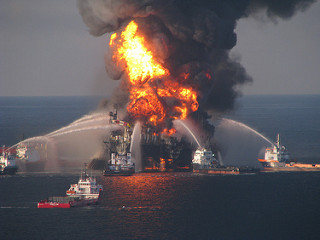 Thirty-five days have passed since the massive oil well blowout in the Gulf of Mexico, which lead to the ongoing oil spill crisis, today described by the White House as the worst spill in United States history. The most conservative estimates place the amount of oil released so far at more than seven million gallons, and the most liberal place the amount at more than 11 million gallons. In comparison, the iconic Exxon Valdez spill released 10.8 million gallons. There is no current estimate for when the oil flow will be stopped.
Thirty-five days have passed since the massive oil well blowout in the Gulf of Mexico, which lead to the ongoing oil spill crisis, today described by the White House as the worst spill in United States history. The most conservative estimates place the amount of oil released so far at more than seven million gallons, and the most liberal place the amount at more than 11 million gallons. In comparison, the iconic Exxon Valdez spill released 10.8 million gallons. There is no current estimate for when the oil flow will be stopped.
In other news, BP has refused to comply with a directive from the EPA that ordered the company to switch to a different chemical in its attempt to clean up the spill. Corexit chemicals, which as we blogged about previously, are considered by some experts to be more dangerous than oil. The Corexit chemicals are prohibited for use on oil spills in England and have been linked to many health problems following their use on the Exxon Valdez spill. BP has used more than 700,000 gallons so far on the spill, which according the head of the EPA is “approaching a world record.”
In addition, there are emerging reports that the chemicals may already be causing illness in the Gulf.WDSU-TV, a New Orleans TV station, reported that some local fishermen contracted by BP to help clean up the spill have become sick. One fisherman said:
“I’ve been coughing up stuff,” Gary Burris said. “Your lungs fill up.” … Burris said that when he went to a doctor after feeling ill on Sunday, the doctor told him his lungs looked like those of a three-pack-a-day smoker, and Burris said he has never smoked.”
We also recently blogged about BP’s attempts to shut down the flow of information about the oil spill — since that time a Mother Jones reporter has been doing a great job Tweeting and writing about her experiences in the region. Some of her most interesting encounters include: cops telling tourists that beaches are still open, but telling all media the beaches are closed and to report to a “BP Information Center;” an interaction with a BP spokeswoman who unknowingly told her that BP has “a lot” of sway over the sheriff’s office; and an attempt to get in touch with the police only to get redirected to voicemail for a BP rep.
In addition, the reporter speaks with a fire chief, who tells her BP lied when it said the inland side of an island is clear of oil, and workers angry that they have been told by BP that the crude they were swimming around in was “red tide,” (caused by algae), runoff, or mud.
An Office of Inspector General report released this week details more inappropriate behavior at the Minerals Management Service, which is responsible for overseeing offshore oil drilling. In a recent blog post, we discussed the many previous concerns about the agency. The new report describes instances in which the MMS allowed the oil industry to write their own inspection reports and then hand them over to regulators, and instances in which MMS officials accepted gifts from oil companies they were supposed to oversee.
Finally, the New York Times reports that in the wake of the oil slick hitting shore, people are becoming increasingly frustrated with the lack of transparency from BP and the absolute failure of its regulators. Louisiana Governor Bobby Jindal criticized the disorganized response to the spill and commented on the scope of the disaster:
“Just under 70 miles of our coast have been hit by oil. Let’s make no mistake that what is at threat here is our way of life.”
——————–
Beth Adelson is a Communications Fellow for the Government Accountability Project, the nation’s leading whistleblower advocacy organization.

